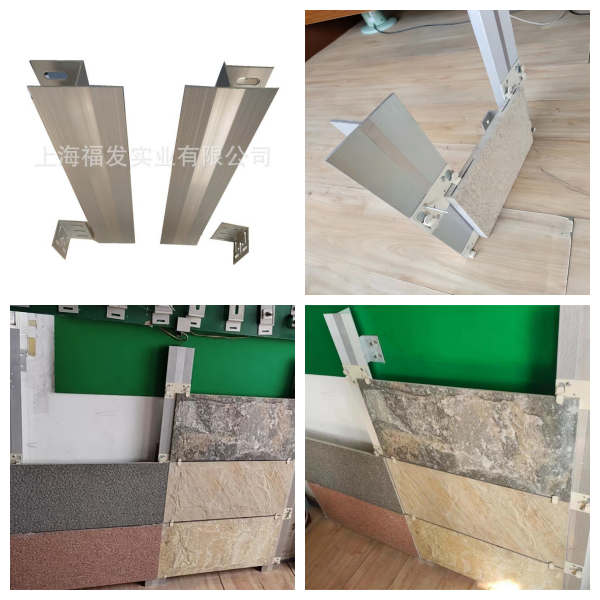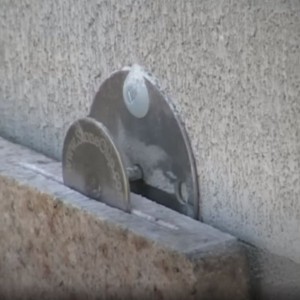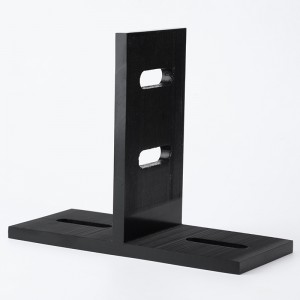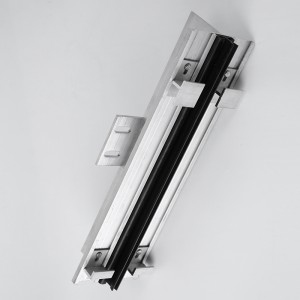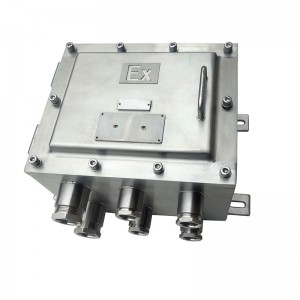The T-bracket system is a structural system used for the installation and support of tile wall.
Its main features and advantages are:
- ** Stable structure ** : The T-shaped bracket can provide reliable support for the tile wall, ensure that the tile can withstand a certain weight and external impact after installation, reduce the risk of tile falling off, and ensure the stability and safety of the wall.
** Easy installation ** : This system is usually designed to be easy to install and operate, and the construction personnel can be assembled and fixed relatively quickly, which helps to improve the construction efficiency and shorten the construction period.
- ** Flexible adjustment ** : The position and flatness of the tile can be fine-tuned to a certain extent to adapt to different wall conditions and construction requirements, and ensure the overall flatness and beauty of the wall.
不锈钢支架
In practical applications, it is often used in large commercial buildings, public facilities and some residential decoration projects with high requirements for wall quality and stability.
Are you considering using such a system? Or do you have questions about a specific aspect of it?
# Stainless Steel Bracket for Stone Cladding Connection
## 1. General Introduction
This stainless – steel bracket is specifically designed for connecting stone claddings. Crafted from high – quality stainless steel, it offers excellent corrosion resistance and sufficient strength. It serves as a reliable means to secure stones to the building structure, ensuring the stability and safety of the stone cladding system.
## 2. Design Specifications
### 2.1 Material
The bracket is made of [specific stainless - steel model], which complies with relevant national standards. This type of stainless steel exhibits outstanding rust resistance and mechanical properties.
### 2.2 Dimensions
- **Main Bracket**:
- The length of the main bracket is customized according to actual installation requirements, typically ranging from [X] mm to [Y] mm. The width is [Z] mm, and the thickness is [W] mm.
- **Connection Bracket**:
- The length of the connection bracket is [A] mm, the width is [B] mm, and the thickness is [C] mm.
- The dimensional tolerance of each part is controlled within ± [specific tolerance value] mm to ensure accurate installation and compatibility.
### 2.3 Shape
- **Main Bracket**: The overall shape of the main bracket is [describe the shape, e.g., rectangular frame]. This structure ensures stability and can evenly distribute the weight of the stones.
- **Connection Bracket**: The connection bracket features a specially designed [describe the specific shape, e.g., L - shaped, U - shaped]. It is adapted to the connection parts of the stones and the main bracket, enhancing the reliability of the connection.
## 3. Manufacturing Processes
### 3.1 Cutting
High – precision laser cutting equipment is used to ensure accurate cutting dimensions. The cut surface is smooth and free of burrs, cracks, and other defects. The perpendicularity deviation of the cut edge of the component does not exceed ± [specific angular value] degrees.
### 3.2 Welding
Welding is carried out by professional welders, strictly following relevant standards. The [specific welding method, e.g., TIG welding] is employed to ensure that the weld seam is full and uniform, free of welding defects such as pores and slag inclusions. The strength of the welded joint is not lower than that of the base material.
### 3.3 Surface Treatment
After the bracket is processed, a comprehensive surface polishing treatment is performed to achieve a surface roughness of [specific roughness value], improving the appearance quality and corrosion resistance. Additionally, passivation treatment can be carried out as needed to further enhance the corrosion resistance of the stainless steel.
## 4. Installation Steps
### 4.1 Positioning
Based on the design drawings of the stone cladding, accurately mark the installation positions of the stainless – steel brackets on the building structure. Use measuring tools such as levels and theodolites to ensure that the installation positions meet the requirements of levelness and perpendicularity.
### 4.2 Fixing the Main Bracket
Install the main bracket on the building structure according to the marked positions. Use [specific fixing methods, e.g., expansion bolts, chemical anchors] for fixation. The specifications and tightening torque of the fixing bolts should meet the design requirements to ensure the stability of the main bracket.
### 4.3 Installing the Connection Bracket
Install the connection bracket on the main bracket and connect it firmly through [specific connection methods, e.g., welding, bolt connection]. The connection parts should fit tightly without looseness.
### 4.4 Stone Installation
Transport the stones to the installation position. Connect the stones to the connection bracket through the pre – drilled holes or slots on the connection bracket. Use special stone adhesives or mechanical fasteners to ensure a firm connection between the stones and the connection bracket.
### 4.5 Adjustment and Inspection
After the stone installation is completed, use measuring tools such as levels and straightedges to check the flatness and perpendicularity of the stone surface. If there are any deviations, adjust them in a timely manner to ensure that the overall installation quality of the stone cladding meets the requirements.
## 5. Quality Inspection
### 5.1 Visual Inspection
The surface of the bracket should be free of obvious scratches, dents, deformations, and other defects. The surface treatment should be uniform, without any signs of incomplete treatment or discoloration.
### 5.2 Dimensional Inspection
Measure the key dimensions of the bracket using measuring instruments to ensure that they meet the design requirements. Brackets with dimensional deviations exceeding the allowable range should be rectified or scrapped.
### 5.3 Welding Quality Inspection
Use non – destructive testing methods (such as ultrasonic testing, magnetic particle testing) to detect the welding parts to ensure that there are no internal defects in the weld seams. At the same time, visually inspect the weld seams. The surface of the weld seams should be smooth and free of cracks, pores, slag inclusions, and other defects.
### 5.4 Mechanical Property Inspection
Select bracket samples according to a certain proportion for mechanical property tests, including tensile tests, bending tests, etc., to ensure that the strength and toughness of the brackets meet the design requirements.
### 5.5 Corrosion Resistance Inspection
Conduct a salt – spray test on the bracket to simulate the corrosion situation in harsh environments and verify the corrosion resistance of the bracket. The salt – spray test time should meet the requirements of relevant standards. After the test, there should be no obvious rust on the surface of the bracket.
## 6. Packaging and Transportation
### 6.1 Packaging
Before packaging, the brackets should be cleaned and treated to prevent damage and contamination during transportation. Use [specific packaging materials, e.g., plastic film, wooden boxes] for packaging to ensure that the brackets are well – protected during transportation.
### 6.2 Transportation
Choose a professional transportation company for transportation. Necessary fixing and protective measures should be taken during transportation to prevent the brackets from being collided or deformed. For large – sized brackets or bulk transportation, vehicles and routes should be reasonably arranged to ensure safe and timely delivery.
The aluminum alloy bracket supporting system for the stone wall is specially designed for the installation of the stone wall.
石材铝合金支架系统




